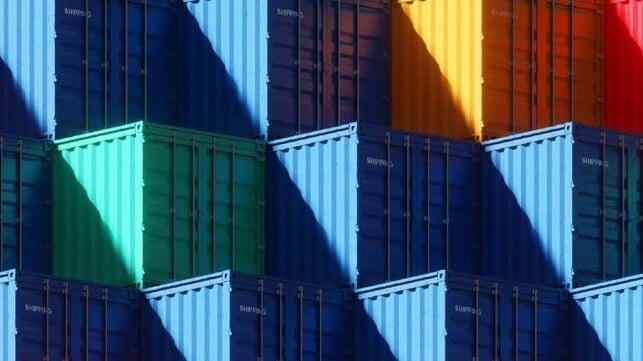How Freight Forwarders Can Contribute to Maritime Decarbonization

A freight forwarder is an organization that helps other companies manage freight transportation across transport modes and geographies. As freight moves from one location, like a factory in China, to another destination, like a distribution centre in Kansas, it will often use multiple modes of transportation. Companies use freight forwarders to simplify the complexity of handling the planning, coordination, documentation, reporting and customs clearance across these different transportation modes and geographies.
Freight forwarders balance the relationship between the shipper (the company that wants to move cargo) and the carrier (the company that moves it). Being an intermediary provides an opportunity to wield influence within the supply chain to help reduce emissions. Here are four ways freight forwarders can support maritime decarbonization.
1. Measurement and education
The most fundamental decarbonization service a freight forwarder can provide to shippers is freight emissions measurement. By utilizing established and accepted methodologies like the Global Logistics Emissions Council Framework, freight forwarders can help shippers better measure and understand the emissions impacts of each shipment. Accurate measurement is foundational for understanding the impact for any decarbonization intervention.
When a freight forwarder is communicating with their clients about the status of shipments, these client interactions are a useful touch point to educate the shipper on their total emissions footprint and maritime decarbonization options. By making supply chain data more transparent, they enable shippers to make low-emission shipping decisions.
2. Demand aggregation
A single shipper is unlikely to persuade a carrier to shift their operations to use low-carbon fuels or provide other low-emissions freight services. However, if there are hundreds or thousands of shippers asking, it sends a more powerful message. This idea of buyers alliances has been used in many sectors. It's also the core principle behind the Zero-emission Maritime Buyers Alliance (ZEMBA) for example that pools shippers' demand for low-emission maritime freight options.
Demand aggregation is a core element of the freight forwarder business model. Some freight forwarders represent the cargo interests of tens of thousands of clients, and they can leverage this client roster to secure discounts in freight rates from carriers. For example, Kuehne + Nagel, a large freight forwarder, claims to have over 400,000 customers.
This leverage could also support the formation of green shipping corridors. When freight forwarders negotiate cargo rates and volumes, they could commit to purchasing cargo volume from ocean carriers using low-carbon fuels on specific trade lanes. Focused efforts targeting specific trade lanes could accelerate broader adoption and lower costs faster than a more diffused decarbonization approach.
3. Routing optimization and vessel efficiency
When a shipper books a shipment with a freight forwarder, their primary concern is that the cargo arrives on time and undamaged. It is up to the freight forwarder to arrange the shipment details such as which ship and how it is routed across the intermodal network.
How cargo is assigned matters immensely for the shipment's emissions. For example, if air freight is prioritized over ocean freight, the emissions can be approximately 50 times higher. While a freight forwarder doesn't control the specific route used a plane, truck, or ship on any given leg of the shipment's overall journey, they can suggest different combinations of transport legs that could lower emissions. This is a complex optimization problem, but it could yield major benefits for freight forwarders and maritime decarbonization.
Not only can routing be optimized, so too can the transportation asset used. For example, within the maritime sector, the IMO's carbon intensity indicator (CII) could be a pragmatic way to compare the emissions intensity of specific vessels. Shippers could indicate preference with their freight forwarder for their cargo to only be carried on ships with a certain CII score, thereby lowering the shipper's scope three emissions footprint.
4. Consolidation and container utilization
Freight forwarders typically know the volume of cargo or the number of pallets that they move on behalf of their clients. When it comes to shipping containers, how much stuff that is in the container, as a fraction of available volume, is called container utilization. Freight forwarders have a financial incentive to move more containers, but a shipper wants to minimize their shipment costs, which is done by maximizing container utilization for each shipment. By keeping container utilization consistently above 80%, shippers need relatively fewer shipments which thus results in relatively fewer emissions, all else being equal.
Sometimes shippers don't need the entire volume of a container. In this instance, freight forwarders can help consolidate shipments from multiple shippers into a single container. This consolidated option is referred to as a less-than-container load (LCL) shipment. This can also help maximize container utilization, thus reducing emissions.
The path for freight forwarders
Freight forwarders interact with thousands of shippers and carriers. As intermediaries between these two stakeholder groups, freight forwarders are uniquely positioned as agents of change for the maritime energy transition. By encouraging emissions measurement, educating clients, aggregating demand, optimizing routing, promoting energy-efficient ships, and maximizing container utilization, freight forwarders can decarbonize global supply chains on a massive scale.
The opinions expressed herein are the author's and not necessarily those of The Maritime Executive.
